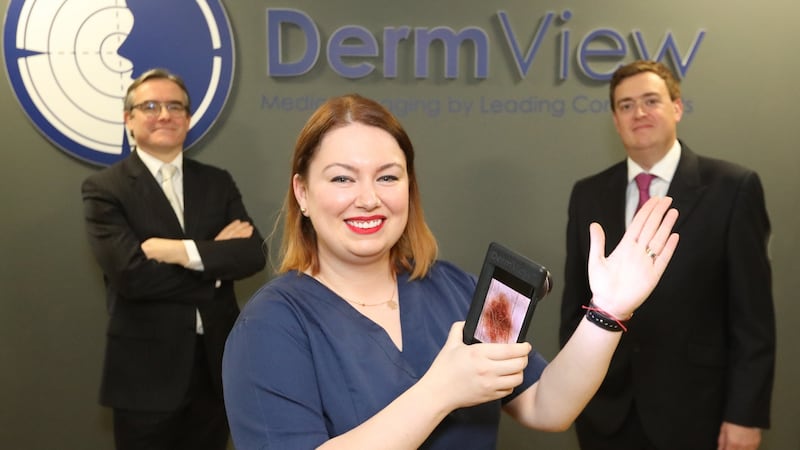Anyone who has had to see a dermatologist in Ireland will regale you with waiting-list woes. If you are going public those waiting times can be very long indeed.
This is the tale of how a sailing excursion between two friends turned into reduced waiting times for dermatology patients and a big win at the Irish Health Care Awards.
Eoin O'Reilly was out sailing with his friend Dr Rupert Barry one day when Barry, a consultant dermatologist, saw something he didn't like.

“Out on the water one day he noticed something on my head and said ‘You need to come and see me’,” says O’Reilly (45), chief executive and co-founder of DermView. “Six weeks later I had an appointment with him, and I needed surgery. About eight weeks after that I was having surgery.”
O’Reilly was fortunate to be dealt with so quickly, and was surprised to discover that people normally wait up to a year for surgery.
“So that’s where the conversation started between myself and Rupert – discussing how can this system be improved.”
The seeds for DermView were sown, and the Carrickmines-based company was incorporated in late 2018. Last year it had a chance to reap from that harvest as the remote dermatology consultancy went live. It has grown to 29 scan centres in 18 counties across Ireland. Centres in Limerick city, Cavan, Monaghan and Sligo are coming soon.
Image quality
Teledermatology is not a new concept – it has been around for years – but the standard of images dermatologists had to work with made remote consultation untrustworthy. This was where O’Reilly and Barry recognised there was a gap in the market to make this service a viable everyday product.
“The technology wasn’t really good enough for consultants to use it,” says O’Reilly, whose background is in IT Solutions Management. “They always felt the image quality was poor and the technology was poor. Consultants wouldn’t actually stand over it and put their medical reputation and their insurance reputation on the line with teledermatology.
“Myself and Rupert got together and we got GPs and other consultants involved. We started about three years ago to try and develop the best image quality and the best teledermatology service that we could build, and that’s really what we have done.
“We spent 2½ years doing research and development and building our system, and we self-funded it and we built it here in Ireland. Our developers are in Ireland so we’ve total control over everything to do with the platform and the system.”
Their main focus was to improve the picture quality and produce the best series of images they could for an accurate diagnosis. “The one thing that makes us totally different is we use dermoscopy – it’s a fairly new technology within dermatology,” he says. “It’s like a little microscope that you can put up against the skin and see under the first couple of millimetres, so you can see the veins and the vessels of the lesions and the moles. That is the difference between a consultant being able to diagnose remotely or not.”
With DermView a patient is seen at GP level and referred to a DermView clinic, where a trained nurse takes images of the mole, lesion or skin complaint using the company’s technology.
The images taken are then sent to a consultant dermatologist and the GP will have the results back with a diagnosis, treatment plan or surgery plan within four weeks.
“You’re cutting out a huge chunk of time,” says O’Reilly. “The current public system waiting list is 46,500 people for dermatology, and that equates to about six years in duration. Privately, it varies between eight and 18 months, depending on the consultant you’re going to see. The waiting lists are huge.
“We have had cases where somebody came in on a Thursday and was scanned by us, and by the following Tuesday or Wednesday they were in having surgery because it was a melanoma or very bad skin cancer. In our current pilot there was somebody who came through DermView with really bad acne and within eight weeks she was getting her treatment. She was a public patient so ordinarily she would have been waiting a few years for a consultation.
“That was a non-urgent referral, but when the consultants were able to see the level of it, they could decide she was serious and she needed to be here quicker. The real difference is the medical need – consultants can now triage as a medical need, rather than just what is traditionally a piece of paper,” he says.
Pilot programme DermView is available privately but it is
part of a pilot programme with the HSE in St James’s Hospital where they take in patients and use teledermatology with the DermView equipment, sending it to the consultants in the next room to make their diagnosis. They then see the patient face-to-face to verify their opinion.
“That’s a true metric and currently we’re keeping about 55 per cent [of patients] out of the hospital. And we’re currently doing work for another hospital, where we are taking patients who are marked as urgent lesional referrals, but they are actually over a year on the waiting list.
“A lot of these are benign, but in the last two weeks we’ve had three melanomas coming through that system. The people who don’t need to see a consultant can be managed by the GP, under consultant guidance, and those who need to come into the hospital are brought in in a timeframe that warrants their concerns.”
The Enterprise Ireland high potential start-up is in a seed funding round for a €2 million raise for expansion and technology development, and it won Gold in the Best Use of Information Technology category at the 2020 Irish Healthcare Awards.
DermView is planning to have a scan centre in every county in Ireland by summer and is eyeing up expansion into the UK in a similar timescale.










